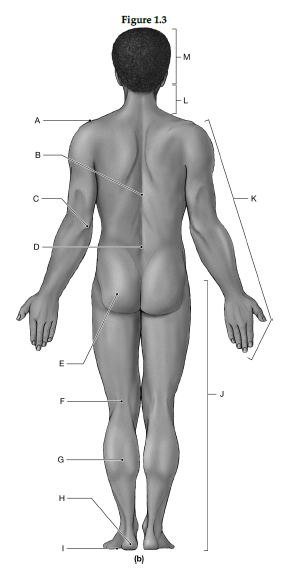Using the figure below, identify the labeled part.

1) Label A: ______________________________
2) Label B: ______________________________
3) Label C: ______________________________
4) Label D: ______________________________
5) Label E: ______________________________
6) Label F: ______________________________
7) Label G: ______________________________
8) Label H: ______________________________
9) Label I: ______________________________
10) Label J: ______________________________
11) Label K: ______________________________
12) Label L: ______________________________
13) Label M: ______________________________
1) Shoulder (acromial)
2) Dorsum or back (dorsal)
3) Olecranon or back of elbow (olecranal)
4) Lumbus or loin (lumbar)
5) Gluteus or buttock (gluteal)
6) Popliteus or back of knee (popliteal)
7) Sura or calf (sural)
8) Calcaneus or heel of foot (calcaneal)
9) Planta or sole of foot (plantar)
10) Lower limb
11) Upper limb
12) Cervicis or neck (cervical)
13) Cephalon or head (cephalic)
You might also like to view...
Spermatogenesis
a. occurs in the epididymis b. begins with a spermatozoan c. is controlled by both testosterone and FSH d. has all of the above characteristics e. has none of the above characteristics
The sleep-wake cycle is controlled by interactions among how many neural systems?
a. 1 b. 2 c. 3 d. 4 e. 5
On the Oxygen-Hemoglobin dissociation curve below, oxygen partial pressure of 35 mm Hg corresponds to:
a) 75% of hemoglobin unloaded its oxygen to tissues b) 25% hemoglobin saturation c) 65% hemoglobin saturation d) 25% of hemoglobin unloaded its oxygen to tissues
The first stage of labor is the _______ stage.
a. dilation b. expulsion c. placental d. decidual e. noenate